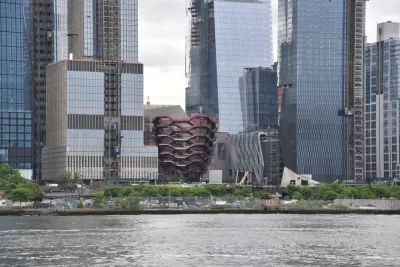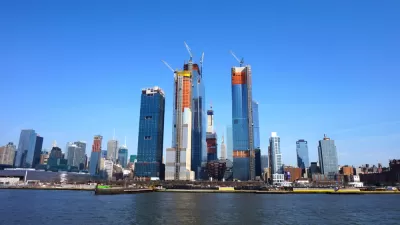Curbed Architecture Critic Alexandra Lange provides everything you need to know about the $25 billion, "city within the city" that opened to the public in Manhattan today. Also, the review isn't exactly positive.

Alexandra Lange reviews the Hudson Yards on the day of the mammoth development project's opening day in New York City.
The $25 billion project has been described as the largest private real estate development in U.S. history and a "future city." Lange is neither taken by those prospects, nor impressed with the attempt.
The problem of the design of Hudson Yards, the 28-acre, $25 billion development built on a platform over Penn Station’s working railroad tracks, is that there is no contrast. No weirdness, no wildness, nothing off book. The megaproject was built by an all-star team of designers, but in the end, it’s impossible to tell the difference between the corporate and the artistic.
Lange's review walks the reader through the development, with vantages offered from the High Line, specific towers in the project, like 55 Hudson Yards and 15 Hudson Yards ("maybe they need names?" asks Lange, rhetorically), and, of course, The Vessel.
Whatever you call Heatherwick Studio’s Vessel—the wastebasket, the egg-crate, the Escher-brought-to-life, the basketball net, the Great Doner Kebab—it is the opposite of those examples. Not temporary, not cuddly, not delicate. It looks just like its renderings except possibly more perfect. I had mentally assigned it an outer cladding of weathering steel; with everything else so smooth and shiny, surely Vessel would have an industrial flavor? But no—Heatherwick Studio leaned into the fractal nature of its design, and the cladding, copper-colored steel, has a mirror finish like Anish Kapoor’s Bean in Chicago’s Millennium Park, welcoming our irresistible impulse to selfie. As we assembled on the plaza below it, the underside of the upper tiers crisply reflected us as ants in bright orange safety vests.
Finally, there's the issue of Hudson Yards becoming the first "North American smart city." Here, Lange dispatches with the utopian dreams of techno-optimists:
Ultimately, though, does it matter? For all the talk of Hudson Yards as being the first North American smart city, it doesn’t feel like the future, except for perhaps the video screens that advertise, offer touchscreen wayfinding, ticketing, and—surprise!—enclose cameras that watch your every move. The majority of innovations called out on the press packet sheet labeled “Engineered City” are largely under the hood: A constant stream of inputs monitored by “operations managers” will allow Hudson Yards, the sentient being, “to monitor and react to traffic patterns, air quality, power demands, temperature and pedestrian flow to create the most efficiently navigated and environmentally attuned neighborhood in New York.”
The article has pretty much everything you could hope for from a design review of the largest private development in U.S. history—images, links, Twitter jokes, and even a William H. Whyte reference.
FULL STORY: At Hudson Yards, the future isn’t now

Maui's Vacation Rental Debate Turns Ugly
Verbal attacks, misinformation campaigns and fistfights plague a high-stakes debate to convert thousands of vacation rentals into long-term housing.

Planetizen Federal Action Tracker
A weekly monitor of how Trump’s orders and actions are impacting planners and planning in America.

San Francisco Suspends Traffic Calming Amidst Record Deaths
Citing “a challenging fiscal landscape,” the city will cease the program on the heels of 42 traffic deaths, including 24 pedestrians.

Adaptive Reuse Will Create Housing in a Suburban Texas Strip Mall
A developer is reimagining a strip mall property as a mixed-use complex with housing and retail.

Study: Anti-Homelessness Laws Don’t Work
Research shows that punitive measures that criminalized unhoused people don’t help reduce homelessness.

In U.S., Urban Gondolas Face Uphill Battle
Cities in Latin America and Europe have embraced aerial transitways — AKA gondolas — as sustainable, convenient urban transport, especially in tricky geographies. American cities have yet to catch up.
Urban Design for Planners 1: Software Tools
This six-course series explores essential urban design concepts using open source software and equips planners with the tools they need to participate fully in the urban design process.
Planning for Universal Design
Learn the tools for implementing Universal Design in planning regulations.
Heyer Gruel & Associates PA
JM Goldson LLC
Custer County Colorado
City of Camden Redevelopment Agency
City of Astoria
Transportation Research & Education Center (TREC) at Portland State University
Jefferson Parish Government
Camden Redevelopment Agency
City of Claremont




























